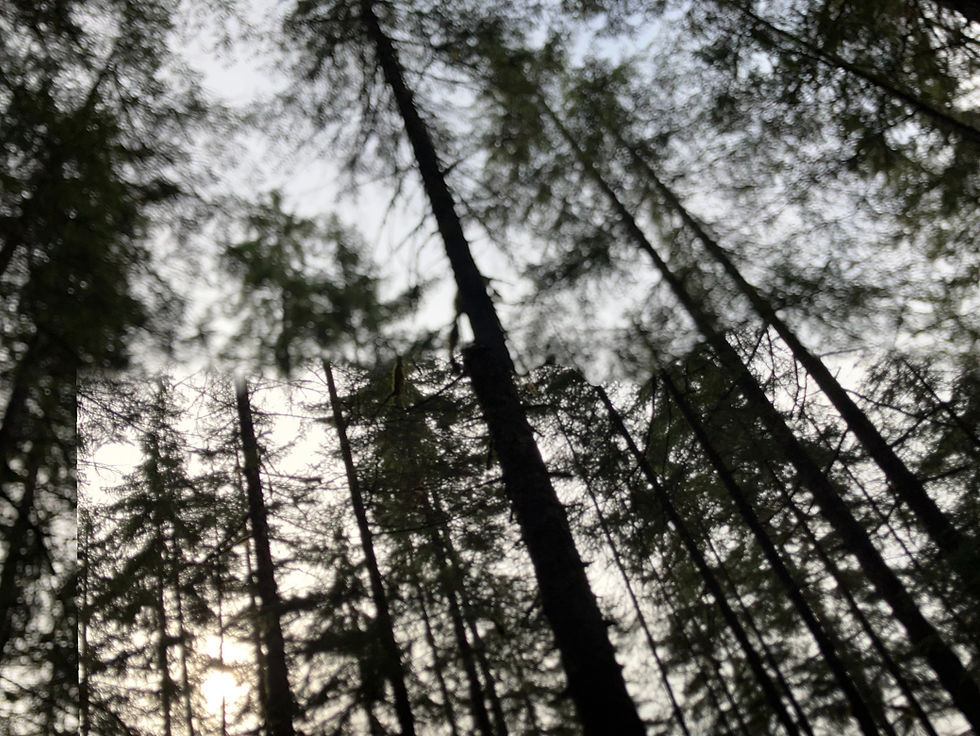Songs of the Humpback
- stellahdawson
- Jun 22, 2024
- 3 min read

I have heard the songs of the humpback whale. I had read the sounds were unearthly, but I was not prepared to be moved when I heard them. It was haunting, ethereal, other worldly.
The whale-watching trip began like many others. After our walk through the rainforest, the boat picked up my group on the rocky beach. The afternoon was warm and the glacier was shining white across the channel. We headed out into calm waters, the mountains mirrored in the icy deep and the skies a watery blue. Ten minutes in, a guest gasped and pointed to a pear-shaped fountain some distance off. Captain Krechelle steered the boat in the direction of the whale spout and as we neared, the humpback heaved itself fully from the water, twisted its body in midair and belly-flopped backwards with a gigantic splash, flashing the whites of its pectoral fins.
“Oooh! Loooook!”
“Oh my god!”
“Did you SEE that?”
“Mom! Did you get a video?”
And the humpback came back to the surface, spouted, snorted, dove and did it again, and again, and again. We gasped and exclaimed -- guests, captain and guide alike -- and we didn’t dare look away. The whale kept breaching and crashing back into the water as if enjoying the sheer exuberance of living.
That alone was performance enough for an outstanding whale-watching trip. We limit each visit to each whale to 30 minutes and stay at least 100 years away to minimize any interference with the marine life, so after a while the captain moved on, heading further up the channel to where several boats were gathered. There she cut the engines and dropped a long microphone into the water and told us to wait and watch on the starboard side of the boat. Gulls gathered in a large group on the surface of the smooth water. We waited quietly, warmed by the sun on a windless sea.
Suddenly, an eruption. Out of the water burst five, six, seven, eight triangular-shaped gunship-gray shapes in a melee of movement. One giant mouth in the middle opened wide in a gigantic V, gulping, bumps and barnacles on its shiny nostrum clearly visible. Water gushed from its mouth, water seethed and splashed. Fins, mouths, humps, flukes lashed about in a frenzy of feeding, and then the water fell calm as quickly as it began and the whales swam in leisurely circles until they hunched up their bodies again and dived into the deep.
All was quiet at first. Then I began to hear the sounds. At first a deep warbling, trumpeting sound, made to round up the herring fish into a tight circle inside the net of bubbles that other whales had blown beneath the surface. The sounds began to heighten in intensity and speed, to slide up the scale, like fingers rubbed faster and faster around a crystal wine glass, and to whirr like the hairs of a bow drawn slowly across a finely tuned violin. The sounds sent tingles up my spine. Through a crease in the universe, I had slipped into another world.
These were the sounds of the humpback whales. Once you have heard them, you are changed.
The whales communicate, imitate, coordinate. They have sequences of sounds they learn and copy. They add to their repertoire each year, new chords and phrases. We were listening to the sounds made for bubble-net feeding, a coordinated group activity performed by only 200 whales in the Northern Pacific region who have learned this method to round up herring into a tight bunch to maximize feeding.
Humpback whales sing when they begin migrating, the males when they gather to mate. They can sing together for 30 minutes at a time. We don’t know why exactly or what all the sounds mean. But we do know they have the intelligence to communicate over hundreds of miles, whistling, echoing, clicking, vibrating, whirring, warbling, trumpeting, calling into an eternal space that lies beyond our comprehension.
I went to a talk by Dr. Fred Sharpe, a whale biologist. He said that astro-biologists (did you even know there is such a thing?) are asking what the sounds of humpback whales can teach us about communicating with intelligent life forms in the outer universe. Are they sending us messages we cannot see, cannot hear or do not know how to read? How can we decode them? The research is backed by NASA, NOAA and the SETI Institute which searches for extraterrestrial intelligence.
The first recordings of the humpback whale was released in 1970 by Dr. Robert Payne after he heard tapes made by a naval officer Frank Watling who had picked up the unusual sounds while listening for Soviet submarine activity off Bermuda https://www.youtube.com/watch?v=sjkxUA041nM.
Fifty years later, we still cannot speak their language. But listen to the sounds of the humpback whale and slip into another eternity.
Photo credit MissionBlue https://missionblue.org/2012/12/photo-of-the-day-a-breaching-humpback-whale/










Comments